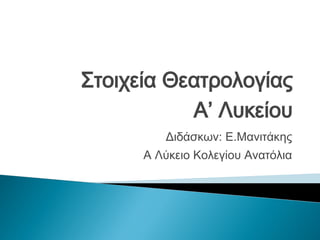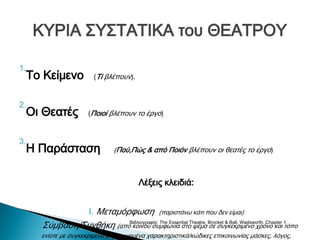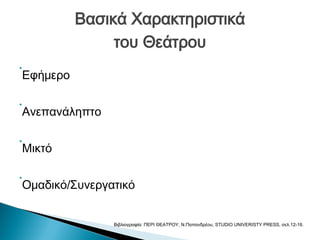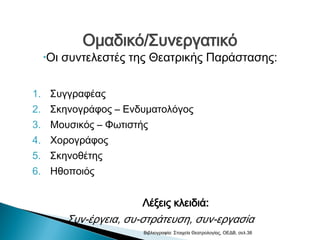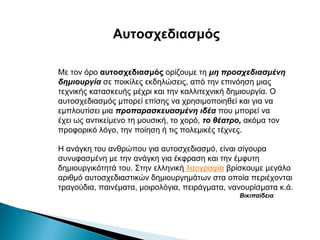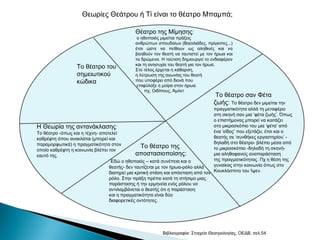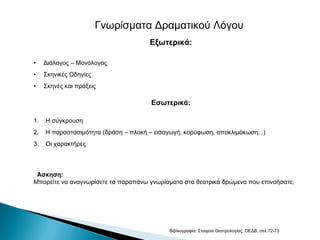Stoixeia theatrologias
- 1. ќ£ѕДќњќєѕЗќµќѓќ± ќШќµќ±ѕДѕБќњќїќњќ≥ќѓќ±ѕВ ќСвАЩ ќЫѕЕќЇќµќѓќњѕЕ ќФќєќіќђѕГќЇѕЙќљ: ќХ.ќЬќ±ќљќєѕДќђќЇќЈѕВ ќС ќЫѕНќЇќµќєќњ ќЪќњќїќµќ≥ќѓќњѕЕ ќСќљќ±ѕДѕМќїќєќ±
- 2. ќЪќ•ќ°ќЩќС ќ£ќ•ќ£ќ§ќСќ§ќЩќЪќС ѕДќњѕЕ ќШќХќСќ§ќ°ќЯќ• 1. 2. 3. ќ§ќњ ќЪќµќѓќЉќµќљќњ ќЯќє ќШќµќ±ѕДќ≠ѕВ (ќ§ќѓ ќ≤ќїќ≠ѕАќњѕЕќљ). (ќ†ќњќєќњќѓ ќ≤ќїќ≠ѕАќњѕЕќљ ѕДќњ ќ≠ѕБќ≥ќњ) ќЧ ќ†ќ±ѕБќђѕГѕДќ±ѕГќЈ (ќ†ќњѕН,ќ†ѕОѕВ & ќ±ѕАѕМ ќ†ќњќєѕМќљ ќ≤ќїќ≠ѕАќњѕЕќљ ќњќє ќЄќµќ±ѕДќ≠ѕВ ѕДќњ ќ≠ѕБќ≥ќњ) ќЫќ≠ќЊќµќєѕВ ќЇќїќµќєќіќєќђ: I. ќЬќµѕДќ±ќЉѕМѕБѕЖѕЙѕГќЈ (ѕАќ±ѕБќєѕГѕДќђќљѕЙ ќЇќђѕДќє ѕАќњѕЕ ќіќµќљ ќµќѓќЉќ±ќє) II.ќ£ѕНќЉќ≤ќ±ѕГќЈ/ќ£ѕЕќљќЄќЃќЇќЈ (ќ±ѕАѕМќТќєќ≤ќїќєќњќ≥ѕБќ±ѕЖќѓќ±: The Essential Theatre, Brocket & Ball, Wadsworth, Chapter 1. ќЇќњќєќљќњѕН ѕГѕЕќЉѕЖѕЙќљќѓќ± ѕГѕДќњ ѕИќ≠ќЉќ± ѕГќµ ѕГѕЕќ≥ќЇќµќЇѕБќєќЉќ≠ќљќњ ѕЗѕБѕМќљќњ ќЇќ±ќє ѕДѕМѕАќњ ќµќљќѓќњѕДќµ ќЉќµ ѕГѕЕќ≥ќЇќµќЇѕБќєќЉќ≠ќљќ± ѕГѕЕќЉѕЖѕЙќљќЈќЉќ≠ќљќ± ѕЗќ±ѕБќ±ќЇѕДќЈѕБќєѕГѕДќєќЇќђ/ќЇѕОќіќєќЇќµѕВ ќµѕАќєќЇќњќєќљѕЙќљќѓќ±ѕВ ќЉќђѕГќЇќµѕВ, ќїѕМќ≥ќњѕВ,
- 3. ќТќ±ѕГќєќЇќђ ќІќ±ѕБќ±ќЇѕДќЈѕБќєѕГѕДќєќЇќђ ѕДќњѕЕ ќШќµќђѕДѕБќњѕЕ вАҐ вАҐ вАҐ вАҐ ќХѕЖќЃќЉќµѕБќњ ќСќљќµѕАќ±ќљќђќїќЈѕАѕДќњ ќЬќєќЇѕДѕМ ќЯќЉќ±ќіќєќЇѕМ/ќ£ѕЕќљќµѕБќ≥ќ±ѕДќєќЇѕМ ќТќєќ≤ќїќєќњќ≥ѕБќ±ѕЖќѓќ±: ќ†ќХќ°ќЩ ќШќХќСќ§ќ°ќЯќ•, ќЭ.ќ†ќ±ѕАќ±ќљќіѕБќ≠ќњѕЕ, STUDIO UNIVERISTY PRESS, ѕГќµќї.12-16.
- 4. ќЯќЉќ±ќіќєќЇѕМ/ќ£ѕЕќљќµѕБќ≥ќ±ѕДќєќЇѕМ вАҐќЯќє ѕГѕЕќљѕДќµќїќµѕГѕДќ≠ѕВ ѕДќЈѕВ ќШќµќ±ѕДѕБќєќЇќЃѕВ ќ†ќ±ѕБќђѕГѕДќ±ѕГќЈѕВ: 1. ќ£ѕЕќ≥ќ≥ѕБќ±ѕЖќ≠ќ±ѕВ 2. ќ£ќЇќЈќљќњќ≥ѕБќђѕЖќњѕВ вАУ ќХќљќіѕЕќЉќ±ѕДќњќїѕМќ≥ќњѕВ 3. ќЬќњѕЕѕГќєќЇѕМѕВ вАУ ќ¶ѕЙѕДќєѕГѕДќЃѕВ 4. ќІќњѕБќњќ≥ѕБќђѕЖќњѕВ 5. ќ£ќЇќЈќљќњќЄќ≠ѕДќЈѕВ 6. ќЧќЄќњѕАќњќєѕМѕВ ќЫќ≠ќЊќµќєѕВ ќЇќїќµќєќіќєќђ: ќ£ѕЕќљ-ќ≠ѕБќ≥ќµќєќ±, ѕГѕЕ-ѕГѕДѕБќђѕДќµѕЕѕГќЈ, ѕГѕЕќљ-ќµѕБќ≥ќ±ѕГќѓќ± ќТќєќ≤ќїќєќњќ≥ѕБќ±ѕЖќѓќ±: ќ£ѕДќњќєѕЗќµќѓќ± ќШќµќ±ѕДѕБќњќїќњќ≥ќѓќ±ѕВ, ќЯќХќФќТ, ѕГќµќї.38
- 5. ќСѕЕѕДќњѕГѕЗќµќіќєќ±ѕГќЉѕМѕВ ќЬќµ ѕДќњќљ ѕМѕБќњ ќ±ѕЕѕДќњѕГѕЗќµќіќєќ±ѕГќЉѕМѕВ ќњѕБќѓќґќњѕЕќЉќµ ѕДќЈ ќЉќЈ ѕАѕБќњѕГѕЗќµќіќєќ±ѕГќЉќ≠ќљќЈ ќіќЈќЉќєќњѕЕѕБќ≥ќѓќ± ѕГќµ ѕАќњќєќЇќѓќїќµѕВ ќµќЇќіќЈќїѕОѕГќµќєѕВ, ќ±ѕАѕМ ѕДќЈќљ ќµѕАќєќљѕМќЈѕГќЈ ќЉќєќ±ѕВ ѕДќµѕЗќљќєќЇќЃѕВ ќЇќ±ѕДќ±ѕГќЇќµѕЕќЃѕВ ќЉќ≠ѕЗѕБќє ќЇќ±ќє ѕДќЈќљ ќЇќ±ќїќїќєѕДќµѕЗќљќєќЇќЃ ќіќЈќЉќєќњѕЕѕБќ≥ќѓќ±. ќЯ ќ±ѕЕѕДќњѕГѕЗќµќіќєќ±ѕГќЉѕМѕВ ќЉѕАќњѕБќµќѓ ќµѕАќѓѕГќЈѕВ ќљќ± ѕЗѕБќЈѕГќєќЉќњѕАќњќєќЈќЄќµќѓ ќЇќ±ќє ќ≥ќєќ± ќљќ± ќµќЉѕАќїќњѕЕѕДќѓѕГќµќє ќЉќєќ± ѕАѕБќњѕАќ±ѕБќ±ѕГќЇќµѕЕќ±ѕГќЉќ≠ќљќЈ ќєќіќ≠ќ± ѕАќњѕЕ ќЉѕАќњѕБќµќѓ ќљќ± ќ≠ѕЗќµќє ѕЙѕВ ќ±ќљѕДќєќЇќµќѓќЉќµќљќњ ѕДќЈ ќЉќњѕЕѕГќєќЇќЃ, ѕДќњ ѕЗќњѕБѕМ, ѕДќњ ќЄќ≠ќ±ѕДѕБќњ, ќ±ќЇѕМќЉќ± ѕДќњќљ ѕАѕБќњѕЖќњѕБќєќЇѕМ ќїѕМќ≥ќњ, ѕДќЈќљ ѕАќњќѓќЈѕГќЈ ќЃ ѕДќєѕВ ѕАќњќїќµќЉќєќЇќ≠ѕВ ѕДќ≠ѕЗќљќµѕВ. ќЧ ќ±ќљќђќ≥ќЇќЈ ѕДќњѕЕ ќ±ќљќЄѕБѕОѕАќњѕЕ ќ≥ќєќ± ќ±ѕЕѕДќњѕГѕЗќµќіќєќ±ѕГќЉѕМ, ќµќѓќљќ±ќє ѕГќѓќ≥ќњѕЕѕБќ± ѕГѕЕќљѕЕѕЖќ±ѕГќЉќ≠ќљќЈ ќЉќµ ѕДќЈќљ ќ±ќљќђќ≥ќЇќЈ ќ≥ќєќ± ќ≠ќЇѕЖѕБќ±ѕГќЈ ќЇќ±ќє ѕДќЈќљ ќ≠ќЉѕЖѕЕѕДќЈ ќіќЈќЉќєќњѕЕѕБќ≥ќєќЇѕМѕДќЈѕДќђ ѕДќњѕЕ. ќ£ѕДќЈќљ ќµќїќїќЈќљќєќЇќЃ ќїќ±ќњќ≥ѕБќ±ѕЖќѓќ± ќ≤ѕБќѓѕГќЇќњѕЕќЉќµ ќЉќµќ≥ќђќїќњ ќ±ѕБќєќЄќЉѕМ ќ±ѕЕѕДќњѕГѕЗќµќіќєќ±ѕГѕДќєќЇѕОќљ ќіќЈќЉќєќњѕЕѕБќ≥ќЈќЉќђѕДѕЙќљ ѕГѕДќ± ќњѕАќњќѓќ± ѕАќµѕБќєќ≠ѕЗќњќљѕДќ±ќє ѕДѕБќ±ќ≥ќњѕНќіќєќ±, ѕАќ±ќєќљќ≠ќЉќ±ѕДќ±, ќЉќњќєѕБќњќїѕМќ≥ќєќ±, ѕАќµќєѕБќђќ≥ќЉќ±ѕДќ±, ќљќ±ќљќњѕЕѕБќѓѕГќЉќ±ѕДќ± ќЇ.ќђ. ќТќєќЇќєѕАќ±ќѓќіќµќєќ±
- 6. ќШќµѕЙѕБќѓќµѕВ ќШќµќђѕДѕБќњѕЕ ќЃ ќ§ќѓ ќµќѓќљќ±ќє ѕДќњ ќЄќ≠ќ±ѕДѕБќњ ќЬѕАќ±ќЉѕАќђ; ќШќ≠ќ±ѕДѕБќњ ѕДќЈѕВ ќЬќѓќЉќЈѕГќЈѕВ: ќ§ќњ ќЄќ≠ќ±ѕДѕБќњ ѕДќњѕЕ ѕГќЈќЉќµќєѕЙѕДќєќЇќњѕН ќЇѕОќіќєќЇќ± ќњ ќЈќЄќњѕАќњќєѕМѕВ ќЉќєќЉќµќѓѕДќ±ќє ѕАѕБќђќЊќµќєѕВ ќ±ќљќЄѕБѕОѕАѕЙќљ ѕГѕАќњѕЕќіќ±ќѓѕЙќљ (ќТќ±ѕГќєќїќєќђќіќµѕВ, ѕАѕБќѓќ≥ќЇќєѕАќµѕВ...) ќ≠ѕДѕГќє ѕОѕГѕДќµ ќљќ± ѕАќµќѓќЄќњѕЕќљ ѕЙѕВ ќ±ќїќЈќЄќєќљќ≠ѕВ ќЇќ±ќє ќљќ± ќ≤ќњќЈќЄќњѕНќљ ѕДќњќљ ќЄќµќ±ѕДќЃ ќљќ± ѕДќ±ѕЕѕДќєѕГѕДќµќѓ ќЉќµ ѕДќњќљ ќЃѕБѕЙќ± ќЇќ±ќє ѕДќ± ќіѕБѕОќЉќµќљќ±. ќЧ ѕДќ±ѕНѕДќєѕГќЈ ќіќЈќЉќєќњѕЕѕБќ≥ќµќѓ ѕДќњ ќµќљќіќєќ±ѕЖќ≠ѕБќњќљ ќЇќ±ќє ѕДќЈ ќ±ќљќЈѕГѕЕѕЗќѓќ± ѕДќњѕЕ ќЄќµќ±ѕДќЃ ќ≥ќєќ± ѕДќњќљ ќЃѕБѕЙќ±. ќ£ѕДќњ ѕДќ≠ќїќњѕВ ќ≠ѕБѕЗќµѕДќ±ќє ќЈ ќЇќђќЄќ±ѕБѕГќЈ, ќЈ ќїѕНѕДѕБѕЙѕГќЈ ѕДќЈѕВ ќ±ќ≥ѕЙќљќѓќ±ѕВ ѕДќњѕЕ ќЄќµќ±ѕДќЃ ѕАќњѕЕ ѕЕѕАќњѕЖќ≠ѕБќµќє ќ±ѕАѕМ ќіќµќєќљќђ ѕАќњѕЕ ќµѕАќєѕЖѕНќїќ±ќЊќµ ќЈ ќЉќњќѓѕБќ± ѕГѕДќњќљ ќЃѕБѕЙќ±. ѕАѕЗ, ќЯќєќіќѓѕАќњѕЕѕВ, ќЖќЉќїќµѕД ќ§ќњ ќЄќ≠ќ±ѕДѕБќњ ѕГќ±ќљ ќ¶ќ≠ѕДќ± ќґѕЙќЃѕВ: ќ§ќњ ќЄќ≠ќ±ѕДѕБќњ ќіќµќљ ќЉќєќЉќµќѓѕДќ±ќє ѕДќЈќљ ѕАѕБќ±ќ≥ќЉќ±ѕДќєќЇѕМѕДќЈѕДќ± ќ±ќїќїќђ ѕДќЈ ќЉќµѕДќ±ѕЖќ≠ѕБќµќє ѕГѕДќЈ ѕГќЇќЈќљќЃ ѕГќ±ќљ ќЉќєќ± вАШѕЖќ≠ѕДќ± ќґѕЙќЃѕВвАЩ. ќМѕАѕЙѕВ ќњ ќµѕАќєѕГѕДќЃќЉќњќљќ±ѕВ ќЉѕАќњѕБќµќѓ ќљќ± ќЇќњќєѕДќђќґќµќє ѕГѕДќњ ќЉќєќЇѕБќњѕГќЇѕМѕАќєќњ ѕДќњѕЕ ќЉќєќ± вАШѕЖќ≠ѕДќ±вАЩ ќ±ѕАѕМ ќЧ ќШќµѕЙѕБќѓќ± ѕДќЈѕВ ќ±ќљѕДќ±ќљќђќЇќїќ±ѕГќЈѕВ: ќ≠ќљќ± вАШќµќѓќіќњѕВвАЩ ѕАќњѕЕ ќµќЊќµѕДќђќґќµќє, ќ≠ѕДѕГќє ќЇќ±ќє ќњ ќ§ќњ ќЄќ≠ќ±ѕДѕБќњ -ѕМѕАѕЙѕВ ќЇќ±ќє ќЈ ѕДќ≠ѕЗќљќЈ- ќ±ѕАќњѕДќµќїќµќѓ ќЄќµќ±ѕДќЃѕВ ѕГќµ вАШѕГѕЕќљќЄќЃќЇќµѕВ ќµѕБќ≥ќ±ѕГѕДќЈѕБќѓќњѕЕвАЩ ќЇќ±ќЄѕБќ≠ѕЖѕДќЈ ѕМѕАќњѕЕ ќ±ќљќ±ќЇќїќђѕДќ±ќє (ќЉѕАќњѕБќµќѓ ќЇќ±ќє ќіќЈќїќ±ќіќЃ ѕГѕДќњ ќЄќ≠ќ±ѕДѕБќњ- ќ≤ќїќ≠ѕАќµќє ќЉќ≠ѕГќ± ќ±ѕАѕМ ѕАќ±ѕБќ±ќЉќњѕБѕЖѕЙѕДќєќЇќђ) ќЈ ѕАѕБќ±ќ≥ќЉќ±ѕДќєќЇѕМѕДќЈѕДќ± ѕГѕДќњќљ ќ§ќњ ќЄќ≠ќ±ѕДѕБќњ ѕДќЈѕВ ѕДќњ ќЉќєќЇѕБќњѕГќЇѕМѕАќєќњ -ќіќЈќїќ±ќіќЃ ѕДќЈ ѕГќЇќЈќљќЃќњѕАќњќѓќњ ќЇќ±ќЄѕБќ≠ѕЖѕДќЈ ќЈ ќЇќњќєќљѕЙќљќѓќ± ќ≤ќїќ≠ѕАќµќє ѕДќњќљ ќЉќєќ± ќ±ќїќЈќЄќњѕЖќ±ќљќµќѓѕВ ќ±ќљќ±ѕАќ±ѕБќђѕГѕДќ±ѕГќЈ ќ±ѕАќњѕГѕДќ±ѕГќєoѕАќњќѓѕГќЈѕВ: ќµќ±ѕЕѕДѕМ ѕДќЈѕВ. ѕДќЈѕВ ѕАѕБќ±ќ≥ќЉќ±ѕДќєќЇѕМѕДќЈѕДќ±ѕВ. ќ†ѕЗ ќЈ ќЄќ≠ѕГќЈ ѕДќЈѕВ ќХќіѕО ќњ ќЈќЄќњѕАќњќєѕМѕВ вАУ ќЇќ±ѕДќђ ѕГѕЕќљќ≠ѕАќµќєќ± ќЇќ±ќє ќњ ќ≥ѕЕќљќ±ќѓќЇќ±ѕВ ѕГѕДќЈќљ ќЇќњќєќљѕЙќљќѓќ± ѕМѕАѕЙѕВ ѕГѕДќњ ќЄќµќ±ѕДќЃѕВ- ќіќµќљ ѕДќ±ѕЕѕДќѓќґќµѕДќ±ќє ќЉќµ ѕДќњќљ ќЃѕБѕЙќ±-ѕБѕМќїќњ ќ±ќїќїќђ ќіќєќ±ѕДќЈѕБќµќѓ ќЉќєќ± ќЇѕБќєѕДќєќЇќЃ ѕГѕДќђѕГќЈ ќЇќ±ќє ќ±ѕАѕМѕГѕДќ±ѕГќЈ ќ±ѕАѕМ ѕДќњќљ ќЪќњѕЕќЇќїѕМѕГѕАќєѕДќњ ѕДќњѕЕ ќКѕИќµќљ. ѕБѕМќїќњ. ќ£ѕДќЈќљ ѕАѕБќђќЊќЈ ѕАѕБќ≠ѕАќµќє ќЇќ±ѕДќђ ѕДќЈ ѕГѕДќЃѕГќєќЉќњ ќЉќєќ±ѕВ ѕАќ±ѕБќђѕГѕДќ±ѕГќЈѕВ ќЃ ѕДќЈќљ ќµѕБќЉќЈќљќµќѓќ± ќµќљѕМѕВ ѕБѕМќїќњѕЕ ќљќ± ќ±ќљѕДќєќїќ±ќЉќ≤ќђќљќµѕДќ±ќє ќњ ќЄќµќ±ѕДќЃѕВ ѕМѕДќє ќЈ ѕАќ±ѕБќђѕГѕДќ±ѕГќЈ ќЇќ±ќє ќЈ ѕАѕБќ±ќ≥ќЉќ±ѕДќєќЇѕМѕДќЈѕДќ± ќµќѓќљќ±ќє ќіѕНќњ ќіќєќ±ѕЖќњѕБќµѕДќєќЇќ≠ѕВ ќњќљѕДѕМѕДќЈѕДќµѕВ. ќТќєќ≤ќїќєќњќ≥ѕБќ±ѕЖќѓќ±: ќ£ѕДќњќєѕЗќµќѓќ± ќШќµќ±ѕДѕБќњќїќњќ≥ќѓќ±ѕВ, ќЯќХќФќТ, ѕГќµќї.54
- 7. ќУќљѕЙѕБќѓѕГќЉќ±ѕДќ± ќФѕБќ±ќЉќ±ѕДќєќЇќњѕН ќЫѕМќ≥ќњѕЕ ќХќЊѕЙѕДќµѕБќєќЇќђ: вАҐ ќФќєќђќїќњќ≥ќњѕВ вАУ ќЬќњќљѕМќїќњќ≥ќњѕВ вАҐ ќ£ќЇќЈќљќєќЇќ≠ѕВ ќЯќіќЈќ≥ќѓќµѕВ вАҐ ќ£ќЇќЈќљќ≠ѕВ ќЇќ±ќє ѕАѕБќђќЊќµќєѕВ ќХѕГѕЙѕДќµѕБќєќЇќђ: 1. ќЧ ѕГѕНќ≥ќЇѕБќњѕЕѕГќЈ 2. ќЧ ѕАќ±ѕБќ±ѕГѕДќ±ѕГќєќЉѕМѕДќЈѕДќ± (ќіѕБќђѕГќЈ вАУ ѕАќїќњќЇќЃ вАУ ќµќєѕГќ±ќ≥ѕЙќ≥ќЃ, ќЇќњѕБѕНѕЖѕЙѕГќЈ, ќ±ѕАќњќЇќїќєќЉќђќЇѕЙѕГќЈ...) 3. ќЯќє ѕЗќ±ѕБќ±ќЇѕДќЃѕБќµѕВ ќЖѕГќЇќЈѕГќЈ: ќЬѕАќњѕБќµќѓѕДќµ ќљќ± ќ±ќљќ±ќ≥ќљѕЙѕБќѓѕГќµѕДќµ ѕДќ± ѕАќ±ѕБќ±ѕАќђќљѕЙ ќ≥ќљѕЙѕБќѓѕГќЉќ±ѕДќ± ѕГѕДќ± ќЄќµќ±ѕДѕБќєќЇќђ ќіѕБѕОќЉќµќљќ± ѕАќњѕЕ ќµѕАќєќљќњќЃѕГќ±ѕДќµ; ќТќєќ≤ќїќєќњќ≥ѕБќ±ѕЖќѓќ±: ќ£ѕДќњќєѕЗќµќѓќ± ќШќµќ±ѕДѕБќњќїќњќ≥ќѓќ±ѕВ, ќЯќХќФќТ, ѕГќµќї.72-73

